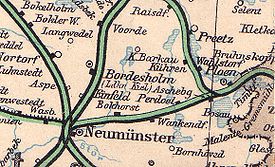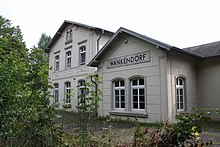Neumünster – Ascheberg railway line
| Neumünster – Ascheberg (Holst) | |||||||||||||||||||||||||||||||||||||||||||||||||||||||||||||||||||||||||||||||||
|---|---|---|---|---|---|---|---|---|---|---|---|---|---|---|---|---|---|---|---|---|---|---|---|---|---|---|---|---|---|---|---|---|---|---|---|---|---|---|---|---|---|---|---|---|---|---|---|---|---|---|---|---|---|---|---|---|---|---|---|---|---|---|---|---|---|---|---|---|---|---|---|---|---|---|---|---|---|---|---|---|---|
|
Former Bokhorst train station
| |||||||||||||||||||||||||||||||||||||||||||||||||||||||||||||||||||||||||||||||||
|
Map of the Neumünster – Ascheberg route (around 1908)
| |||||||||||||||||||||||||||||||||||||||||||||||||||||||||||||||||||||||||||||||||
| Route number (DB) : | 1041 | ||||||||||||||||||||||||||||||||||||||||||||||||||||||||||||||||||||||||||||||||
| Course book range : | 148 (1985) | ||||||||||||||||||||||||||||||||||||||||||||||||||||||||||||||||||||||||||||||||
| Route length: | 26 km | ||||||||||||||||||||||||||||||||||||||||||||||||||||||||||||||||||||||||||||||||
| Gauge : | 1435 mm ( standard gauge ) | ||||||||||||||||||||||||||||||||||||||||||||||||||||||||||||||||||||||||||||||||
|
|||||||||||||||||||||||||||||||||||||||||||||||||||||||||||||||||||||||||||||||||
The railway Neumünster-Ascheberg (Holst) leads from the middle Holstein Neumünster eastward to Ascheberg shortly before the district town of Ploen . The 26-kilometer route is currently closed.
geography
The route leads in the west through flat, mostly agricultural geest landscape . To the east it reaches the lakes and moraines embossed Holstein Switzerland .
history
On May 31, 1866, the Neumünster – Ascheberg (Holst) –Eutin – Neustadt in Holstein line was opened. The operator at that time was the Altona-Kieler Eisenbahn-Gesellschaft , which was nationalized in 1884. The route soon appeared in three parts in the course books. From Ascheberg to Eutin it had become part of the Kiel – Lübeck railway line . The easternmost section of the route from Eutin to Neustadt was henceforth run as a separate route.
From 1912 to 1961 the line in Wankendorf was crossed by the Kleinbahn Kiel – Segeberg . The rail networks were not connected.
The route was operated almost continuously for both passenger and freight traffic. From the 1950s to the 1970s, the longest route for a passenger train was taken by the Büsum – Eutin and later Heide –Neustadt express trains , which crossed the state almost in full width. In the 1970s, these express trains were mostly operated with the 515 series . They only stopped in Wankendorf between Neumünster and Ascheberg and had a travel time of 20 minutes on this section, while the local trains took around 28 minutes. These trains mostly ran as rail buses and some were hauled by a locomotive. Some passenger trains were tied to places beyond the line.
On September 29, 1985 passenger traffic between Neumünster and Ascheberg was stopped. This makes the line the penultimate line in Schleswig-Holstein that was closed for passenger traffic until 2010 (passenger traffic on the Wilster – Brunsbüttel line was discontinued in 1988). Freight traffic followed on November 1, 1995. However, the route was not de-dedicated, but was part of a Schleswig-Holstein-wide route security contract until 2007. However, a railway bridge near the Ascheberg train station was demolished in 1996 and the connecting switch was then expanded. The entrance tracks from the direction of Neumünster are partially built over. In October 2006, the barriers at the Christianstraße level crossing were dismantled and a fence was drawn over the tracks on both sides of the street. The rails remained in the street at the initiative of the city. The bridge over the Dosenbek in the fallow fields is blocked with a railing.
Draisine rides are offered between the Brammerhof near Bokhorst and the Lange Reihe Süd near Wankendorf . The starting point is the former train station in Bokhorst.
The bus line 360 of the Plön district transport company runs from Plön to Neumünster and connects the places along the route that were previously served by rail.
Future of the route
The Neumünster – Ascheberg line has been the subject of many discussions regarding a reopening. A resumption of operations was questionable for a long time, as the route is interrupted and, apart from travelers on the Neumünster – Holstein Switzerland route, no great customer demand is to be expected. The connection from Neumünster to Lübeck has been possible again via Bad Oldesloe since the Neumünster – Bad Oldesloe railway was reopened in 2002 . The state-wide local transport plan (LNVP) therefore no longer provided for further route securing. The district council of the Plön district spoke out in November 2008 against restarting. Some neighboring communities and the parliamentary group of Bündnis 90 / Die Grünen are still interested in maintaining the route.
On June 30, 2009, DB Services Immobilien applied to the Federal Railway Authority in Hamburg to exempt the route from railway operations. During the eight-week objection period, various affected communities and the Rhein-Sieg-Eisenbahn objected to the deedication . In October 2010 the Federal Railway Authority rejected the exemption of the land and thus the deedication of the route.
On January 6, 2010, the Schwentine-Holstein Switzerland Active Region Association decided, at the request of the City of Plön, to financially support a feasibility study to reactivate the Neumünster – Ascheberg route. Cooperation partners of the city of Plön are above all Rhein-Sieg-Eisenbahn GmbH, the city of Neumünster and the newly founded Förderverein Ostholsteinbahn e. V.
On July 15, 2013, the DB AG started another attempt to obtain the exemption of the route from the Federal Railway Authority. Due to a formal error, the application was made again in the Electronic Federal Gazette on August 5, 2013. The exemption was also contradicted here. DB AG then withdrew its application at the end of January 2014.
In the current fourth state-wide local transport plan, the route was newly included for a reactivation perspective, after this had not previously been taken into account in the third local transport plan. The district of Plön has now also undertaken a perspective reassessment of the route after a corresponding district council resolution was passed by a majority.
In October 2018, the Federal Minister of Transport and Digital Infrastructure Andreas Scheuer published the study on the Germany cycle , the detailed planning of which includes the route.
In January 2019, the results of an expert opinion were published which gave an hourly regional train Neumünster – Plön as the preferred option for reactivation. If the route is expanded to 100 km / h and two intermediate stops are operated, the journey time should be 25 minutes, so that only one round-trip is required. A benefit-cost ratio was only achieved for this variant, which at 1.03 is just in the positive range. The costs should amount to 40.24 million euros.
literature
- Erich Staisch (Ed.): The train to the north . Ernst Kabel, Hamburg 1994, ISBN 3-8225-0298-7 .
Web links
Individual evidence
- ↑ Draisinenfreunde Mittelholstein. Retrieved August 29, 2016 .
- ↑ The train has not yet left. Kieler Nachrichten ( Memento from January 30, 2009 in the Internet Archive ), accessed on August 12, 2012
- ↑ Ostholsteiner Anzeiger of October 18, 2010, p. 5
- ↑ Dedication Neumünster - Ascheberg rejected. Eisenbahnjournal Zughalt.de, October 19, 2010, accessed on October 20, 2010 . .
- ^ New impetus for the train to Ascheberg. In: Holsteinischer Courier. January 12, 2010, accessed January 15, 2010 .
- ↑ kcw: reactivation of the railway line Neumünster - Ascheberg. (PDF; 391 kB) In: www.nah.sh. January 23, 2019, accessed January 30, 2019 .



